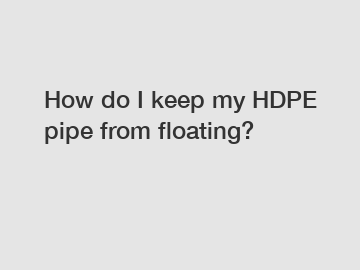Dec. 18, 2023
Rubber & Plastics
How do I keep my HDPE pipe from floating?
Floating of high-density polyethylene (HDPE) pipes can pose a significant challenge in various applications. Whether it is for water supply systems, marine projects, or underground installations, preventing the buoyancy of these pipes is crucial for their efficient functioning. In this article, we will explore different methods and solutions to ensure the stability and secure positioning of HDPE pipes, mitigating the risk of floating.
1. Weighted pipe systems:

One effective approach to prevent HDPE pipes from floating is to use weighted systems. Adding weights to the pipes keeps them submerged and stable, negating the buoyant forces acting upon them. These weights can be clamped onto the pipe or anchored using straps, ensuring they remain in place even in turbulent environments.
2. Concrete encasement:
Another technique widely employed is encasing HDPE pipes in concrete. By embedding the pipe in a concrete structure, its tendency to float is completely eliminated. The buoyancy force is counteracted by the weight of the concrete, providing a solid and secure anchoring solution. Additionally, concrete encasement can enhance the pipe's resistance to external loads and protect it from potential damages.
3. Continuous water filling:
In certain applications, such as underwater or subsea projects, maintaining a continuous water fill within the annular space of the HDPE pipe can prevent buoyancy. By ensuring that the pipe is always filled with water, the hydrostatic pressure inside the pipe counters the buoyant forces acting on it. This method is especially effective when dealing with long horizontal installations or submerged pipelines.
4. Ballast materials:
Further reading:The use of ballast materials is a common practice to keep HDPE pipes from floating. These materials, such as sandbags or gravel, are placed on top of the pipe or secured alongside it to add weight and stability. The choice of ballast material depends on the specific project requirements, considering factors like durability, ease of installation, and environmental concerns.
5. Geotextile wrapping:
Applying geotextile wrapping around HDPE pipes provides additional resistance against buoyancy. The geotextile fabric acts as a permeable barrier, allowing water to flow through but preventing the pipe from floating. This method is particularly beneficial when dealing with softer soils or areas prone to high water tables.
6. Anchor systems:
Using anchor systems can effectively counter the buoyancy forces acting on HDPE pipes. Anchors are installed at regular intervals along the pipe's length, providing secure points of attachment to the ground or surrounding structures. Depending on the project requirements, anchors can be made of steel, concrete blocks, or other heavy materials.
7. Helical screw piles:
For above-ground installations, helical screw piles offer a reliable solution to prevent HDPE pipes from floating. These piles are drilled into the ground, creating a stable foundation for the pipe. The helical shape provides increased resistance against uplift forces, ensuring the pipe remains firmly grounded even in saturated or loosely compacted soils.
In conclusion, preventing HDPE pipes from floating is crucial to maintain the integrity and effectiveness of various applications. The use of weighted systems, concrete encasement, continuous water filling, ballast materials, geotextile wrapping, anchor systems, and helical screw piles are all effective methods to tackle this challenge. Choosing the most suitable approach depends on the specific project requirements, environmental conditions, and budget constraints. By employing these solutions, HDPE pipe buoyancy can be effectively addressed, allowing for safe and reliable operation.
For more hdpe pipe floats price, resistant rubber dredger hoses factory, hdpe dredge pipe manufacturerinformation, please contact us. We will provide professional answers.
Further reading:Related Articles
If you are interested in sending in a Guest Blogger Submission,welcome to write for us!
All Comments ( 0 )